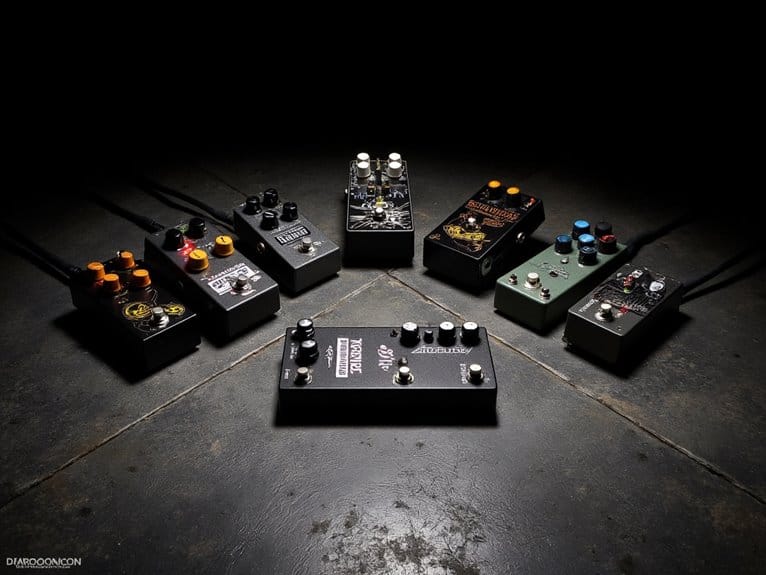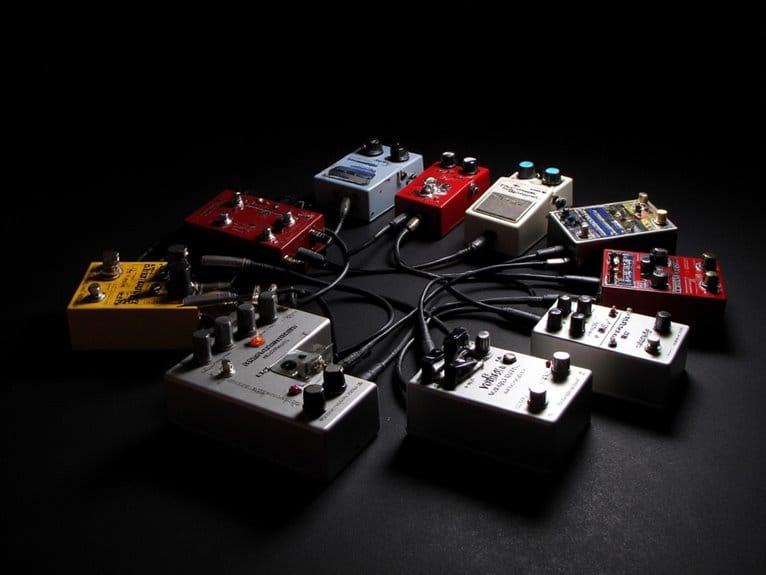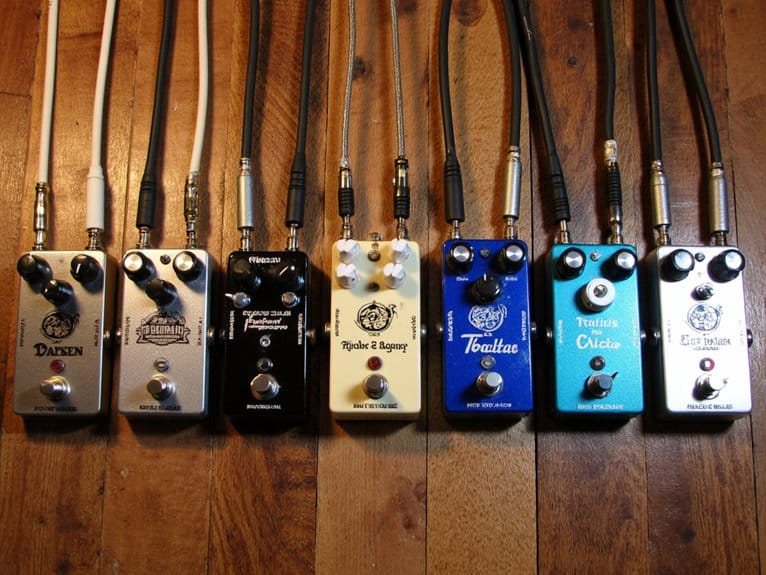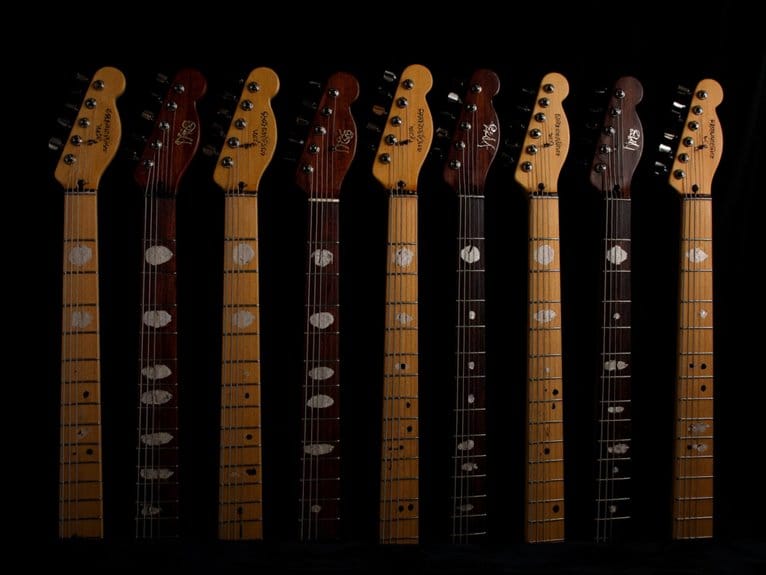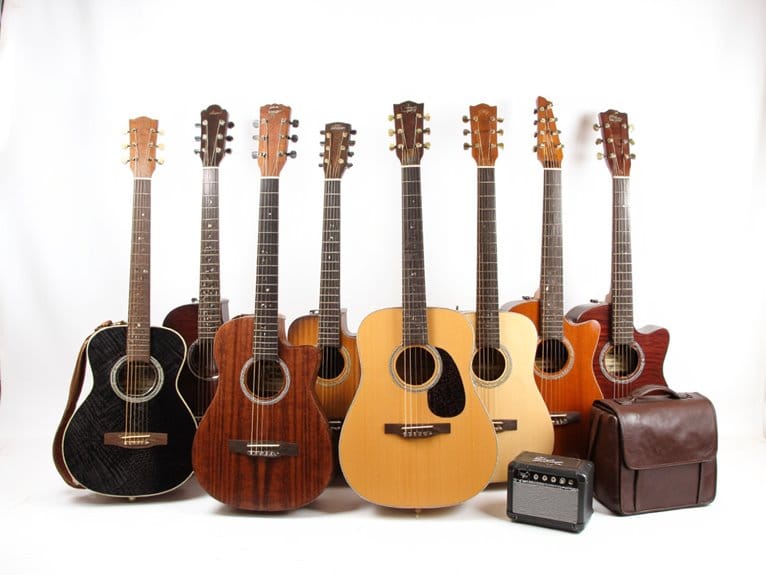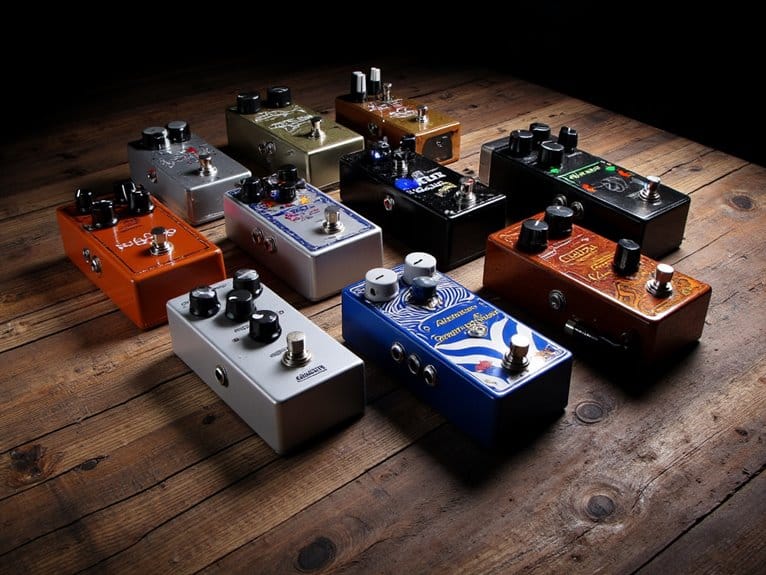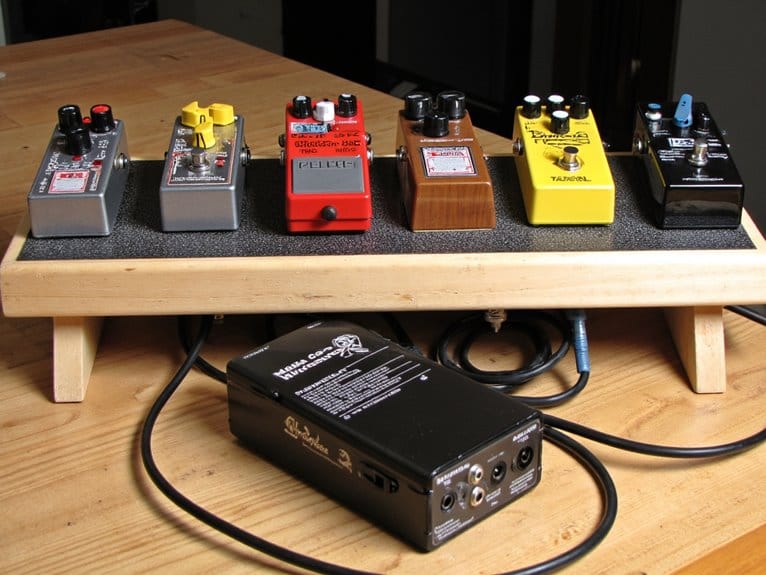10 Best Distortion Pedals for Metal That Will Crush Your Sound
I’ve found that the Boss MT-2 Metal Zone delivers exceptional dual-stage gain circuitry for crushing metal tones, while the EX Inferno Death Metal Pedal offers three versatile modes with true-bypass circuitry that prevents tone loss. The Sondery Metal Distortion provides solid aluminum construction with three distinct modes, and JOYO’s JF-04 achieves 90% tube amplifier quality at budget-friendly prices. Each pedal brings unique characteristics, from the Boss DS-1’s reliable versatility to specialized high-gain monsters, and choosing the right one depends on your specific sonic goals.
We are supported by our audience. When you purchase through links on our site, we may earn an affiliate commission, at no extra cost for you. Learn more.
Notable Insights
- Boss MT-2 Metal Zone delivers thick, tight distortion with dual-stage gain circuitry and versatile tone-shaping controls for metal guitarists.
- EX Inferno Death Metal Pedal offers three high-gain modes (Raw, Brutal, Inferno) with true-bypass circuitry for crushing metal tones.
- Boss ML-2 Metal Core provides ultra-heavy distortion with sharp-edged attack, ideal for aggressive metal and hard rock applications.
- JOYO High Gain Distortion Pedal delivers 90% tube amplifier tone quality with full-range EQ adjustments for versatile metal sounds.
- Heavy Metal Distortion Pedal features six control knobs and noise gate for extensive EQ shaping while maintaining clarity at high gain.
Sondery Metal Distortion Pedal for Electric Guitars (3 Modes)
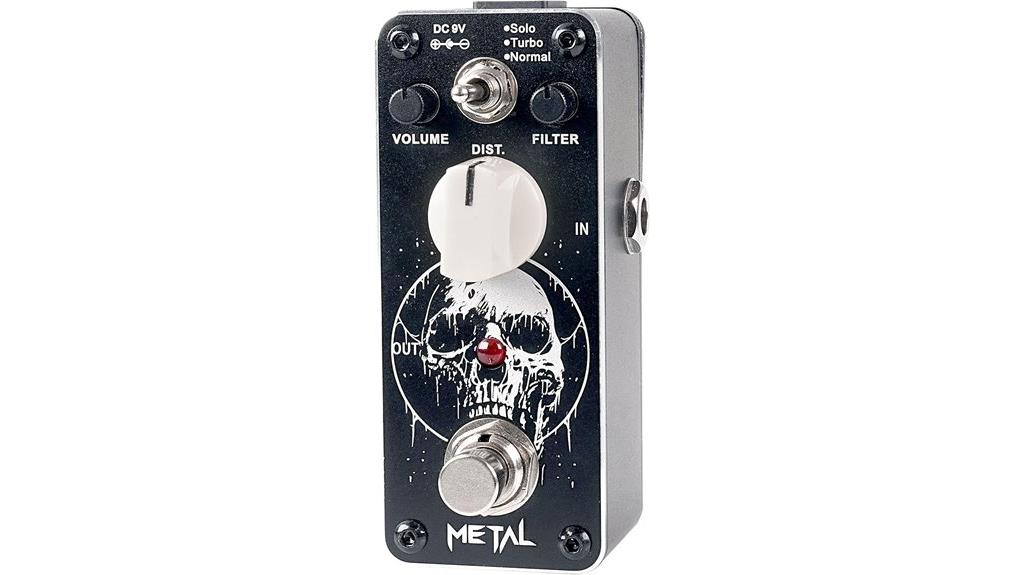
When searching for a distortion pedal that delivers genuine metal tone without breaking the bank, I’ve found the Sondery Metal Distortion Pedal stands out as an excellent choice for guitarists who need versatility in a compact package. You’ll appreciate its three distinct modes—Solo, Turbo, and Normal—which provide switching options from warm vintage distortion to aggressive modern metal sounds. The aluminum alloy construction feels surprisingly solid for such a compact unit, measuring just 3.7 x 1.9 x 1.66 inches, while the anti-skid rubber pad keeps it planted during intense performances. I particularly value the intuitive Volume, Filter, and Distortion controls that make tone-shaping straightforward.
Best For: Budget-conscious guitarists who need a versatile, compact distortion pedal that can handle everything from warm vintage tones to aggressive metal sounds.
Pros:
- Three distinct modes (Solo, Turbo, Normal) offer versatile distortion options from vintage to modern metal
- Solid aluminum alloy construction with anti-skid rubber pad provides durability and stability in a compact 3.7 x 1.9 x 1.66 inch package
- Intuitive Volume, Filter, and Distortion controls with true bypass functionality make tone-shaping straightforward
Cons:
- AC adapter required for power (not included) with no battery option for portable use
- Limited to distortion effects only without additional built-in features like reverb or delay
- Compact size may make precise control adjustments difficult during live performances
EX Inferno Death Metal Distortion Guitar Pedal with 3-Mode Boost Switch
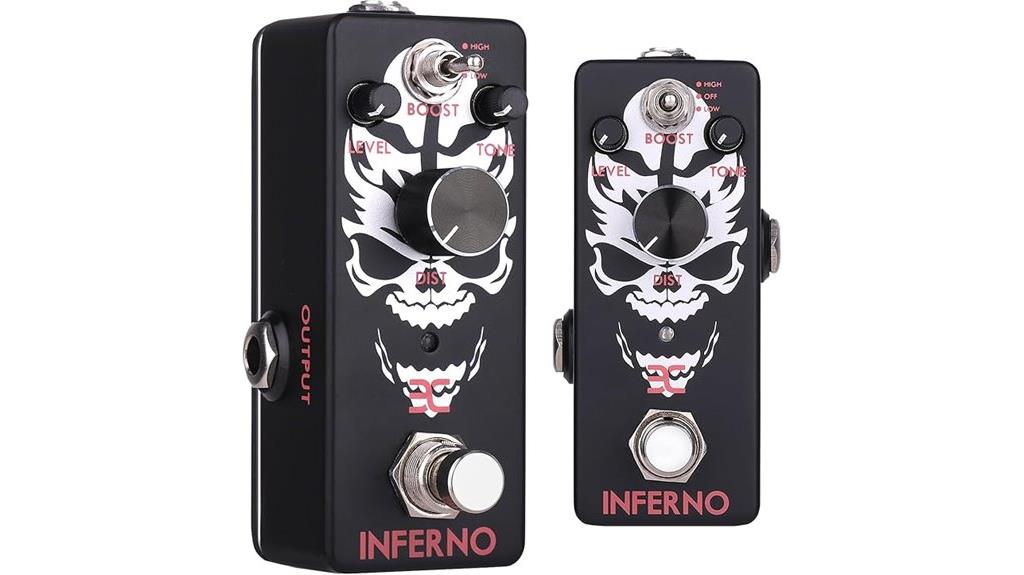
The EX Inferno Death Metal Distortion Guitar Pedal with 3-Mode Boost Switch delivers crushing high-gain tones that’ll satisfy metal purists who demand surgical precision in their crushing assault, featuring three distinct distortion modes—Raw, Brutal, and Inferno—that transform any amplifier into a fire-breathing monster. You’ll appreciate the thorough control setup, which includes Level, Tone, and Distortion knobs that let you dial in everything from tight, punchy rhythm sections to screaming lead chaos. The rugged die-cast construction houses true-bypass analog circuitry, ensuring zero tone loss while the top-mounted jacks accommodate cramped pedalboards perfectly.
Best For: Metal and hard rock guitarists who need versatile high-gain distortion with precise control options for both crushing rhythm work and searing lead tones.
Pros:
- Three distinct distortion modes (Raw, Brutal, Inferno) provide extensive tonal versatility for different metal styles
- True-bypass analog circuitry with rugged die-cast construction ensures reliable performance and zero tone loss
- Compact design with top-mounted jacks and comprehensive control knobs makes it ideal for crowded pedalboards
Cons:
- 9V DC power adapter sold separately, adding to the initial purchase cost
- Limited to metal and high-gain applications, offering little versatility for cleaner or blues-style tones
- May require significant amplifier headroom to fully utilize the pedal’s high-gain capabilities without unwanted feedback
JOYO High Gain Distortion Pedal for Electric Guitar (JF-04)
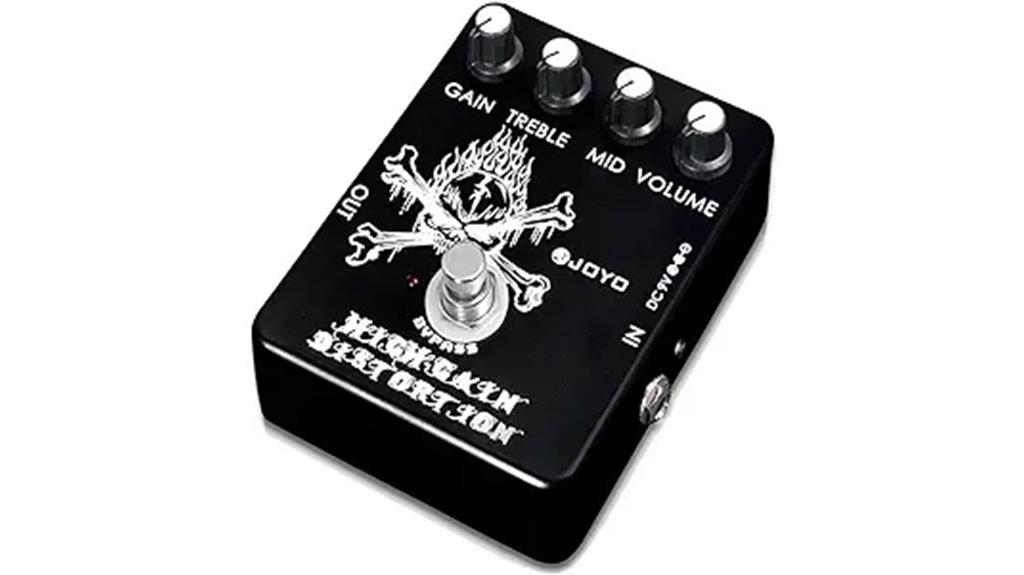
Budget-conscious metal guitarists who refuse to compromise on sound quality will find their perfect match in the JOYO High Gain Distortion Pedal (JF-04), a compact powerhouse that delivers everything from AC/DC’s signature crunch to Metallica’s crushing heavy metal tones. What impresses me most about this aluminum-alloy beast is its ability to achieve 90% of high-end tube amplifier tone quality while maintaining remarkable versatility through full-range EQ adjustments that work seamlessly with both single coils and vintage overdrive setups. Though some users report occasional background noise issues, the pedal’s 4.3-star rating from over 6,000 reviews speaks volumes about its reliability and performance value proposition.
Best For: Budget-conscious metal and rock guitarists who want versatile distortion tones ranging from classic crunch to heavy metal without spending on expensive equipment.
Pros:
- Delivers 90% of high-end tube amplifier tone quality at a fraction of the cost
- Extremely versatile with full-range EQ adjustments suitable for various music styles from blues rock to heavy metal
- Durable aluminum-alloy construction with excellent build quality and reliability
Cons:
- Some units may experience background noise issues during operation
- May not meet expectations for higher-end sound quality compared to premium pedals
- Occasional reports of defects such as non-functional components
Boss MT-2 Metal Zone Distortion Guitar Pedal
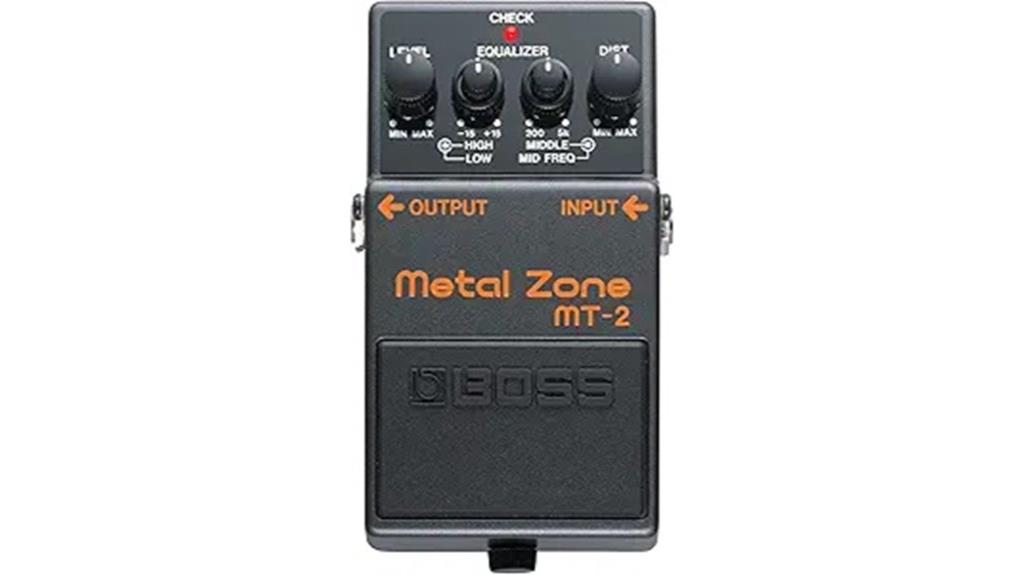
Since its release in 2006, the Boss MT-2 Metal Zone has earned its reputation as the go-to distortion pedal for guitarists who demand crushing high-gain tones without breaking the bank. This compact 6 x 3.8 x 2.7-inch powerhouse delivers dual-stage gain circuitry that produces thick, tight distortion with smooth sustain, making it perfect for everything from high-speed metal rhythms to soaring lead solos. You’ll find its versatility impressive, as users consistently achieve tones ranging from Metallica’s precision to Ozzy’s classic grind. While you might experience slight buzz at maximum settings, proper cables manage this easily, and the pedal’s 4.6-star rating from over 900 customers speaks volumes about its reliability and performance across skill levels.
Best For: Metal guitarists and high-gain enthusiasts who want reliable, crushing distortion tones for heavy rhythms and soaring solos without spending a fortune.
Pros:
- Dual-stage gain circuit delivers thick, tight distortion with smooth sustain perfect for metal and high-gain styles
- Versatile tone-shaping capabilities allow users to dial in specific sounds from Metallica precision to classic Ozzy grind
- Excellent value with strong customer satisfaction (4.6/5 stars) and proven reliability across all skill levels
Cons:
- Slight buzz and feedback issues when running at maximum gain and volume settings
- Power supply cord sold separately, requiring additional purchase for consistent operation
- May be too specialized for players seeking cleaner or lower-gain distortion sounds
Heavy Metal Distortion Guitar Pedal with True Bypass
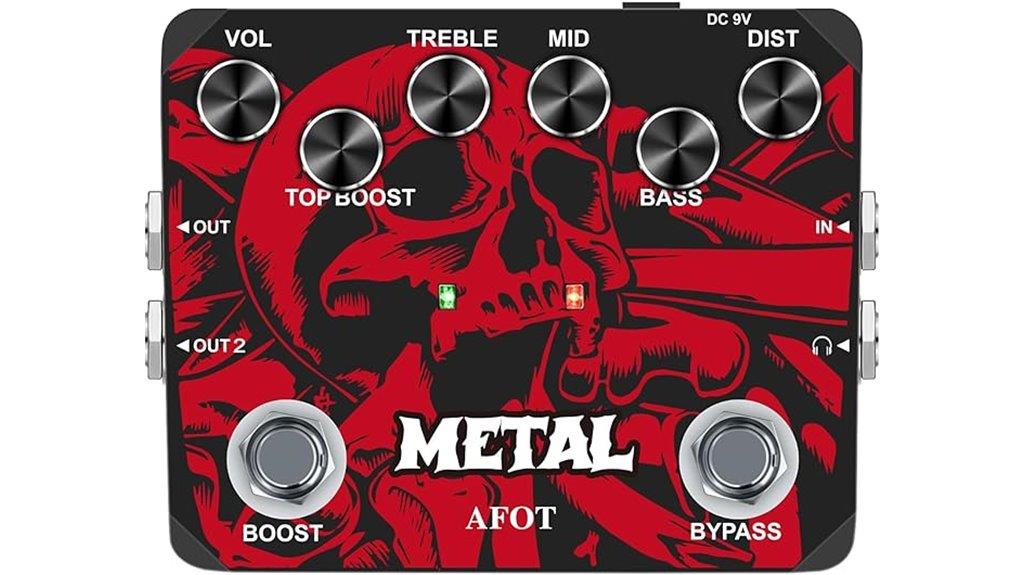
Metal guitarists seeking maximum gain without sacrificing clarity will find their match in the Heavy Metal Distortion Guitar Pedal with True Bypass, a feature-rich unit that packs six dedicated control knobs—Treble, Mid, Bass, Boost, Volume, and Distortion—into a solid metal chassis weighing 14.9 ounces. You’ll appreciate how this pedal maintains definition even at crushing gain levels, delivering tones that range from heavy blues to hard rock with its independent EQ controls. The included noise gate keeps feedback in check during live performances, while the true bypass design preserves your signal integrity when disengaged.
Best For: Metal, rock, and punk guitarists who need maximum gain with clarity and want versatile EQ controls for shaping aggressive distortion tones from heavy blues to hard rock.
Pros:
- Six independent control knobs (Treble, Mid, Bass, Boost, Volume, Distortion) provide exceptional sound shaping versatility
- Maintains clarity and definition even at high gain levels with built-in noise gate to control feedback
- Solid metal chassis construction ensures durability for extensive live performance and rehearsal use
Cons:
- Does not include required 9V DC power adapter
- Some users report minor noise issues at very high gain settings
- Footswitch has a rough feeling according to some user feedback
Boss ML-2 Metal Core Distortion Pedal
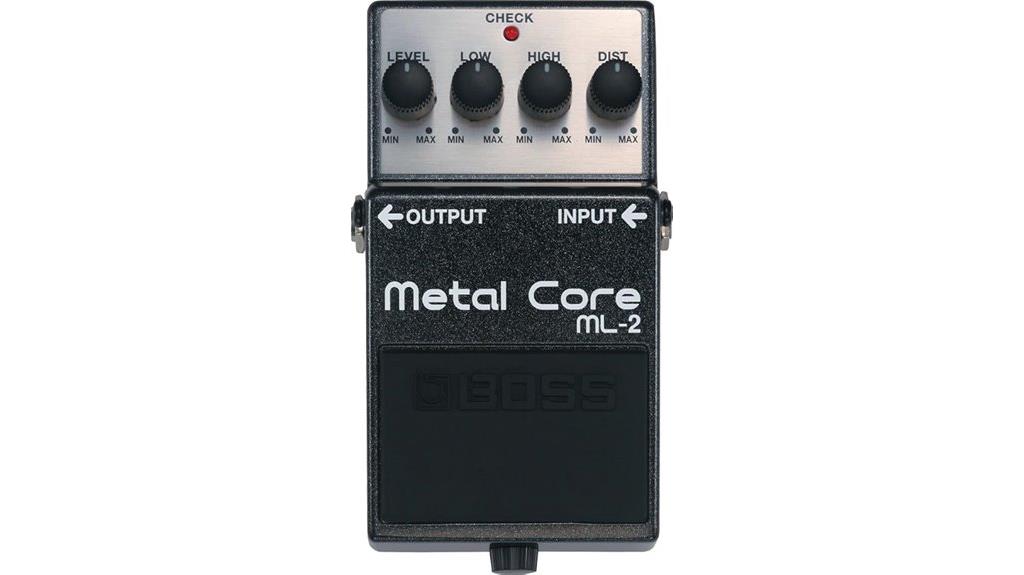
When you’re hunting for that signature crushing sound that defines modern metal, the Boss ML-2 Metal Core Distortion Pedal delivers ultra-heavy distortion with the sharp-edged attack that’ll slice through any mix. This road-tough metal construction pedal won’t quit when you’re pushing boundaries, and honestly, that’s what separates weekend warriors from serious players. The LOW and HIGH controls give you precise tone shaping, while the HIGH setting specifically cranks out that screaming, metallic edge that makes riffs cut like razors. I’ve found the ML-2 excels at crushing metal applications where subtlety takes a backseat to pure sonic devastation.
Best For: Metal guitarists who need ultra-heavy distortion with sharp attack for crushing riffs and cutting through dense mixes.
Pros:
- Ultra-heavy distortion with sharp-edged attack that cuts through any mix
- Road-tough metal construction built to withstand heavy use
- Precise tone shaping with LOW and HIGH controls for screaming metallic edge
Cons:
- Limited versatility outside of heavy metal applications
- May be too aggressive for subtle or clean tones
- Lack of subtlety could overpower lighter musical styles
JOYO Distortion Pedal R Series Heavy Metal (UZI R-03)
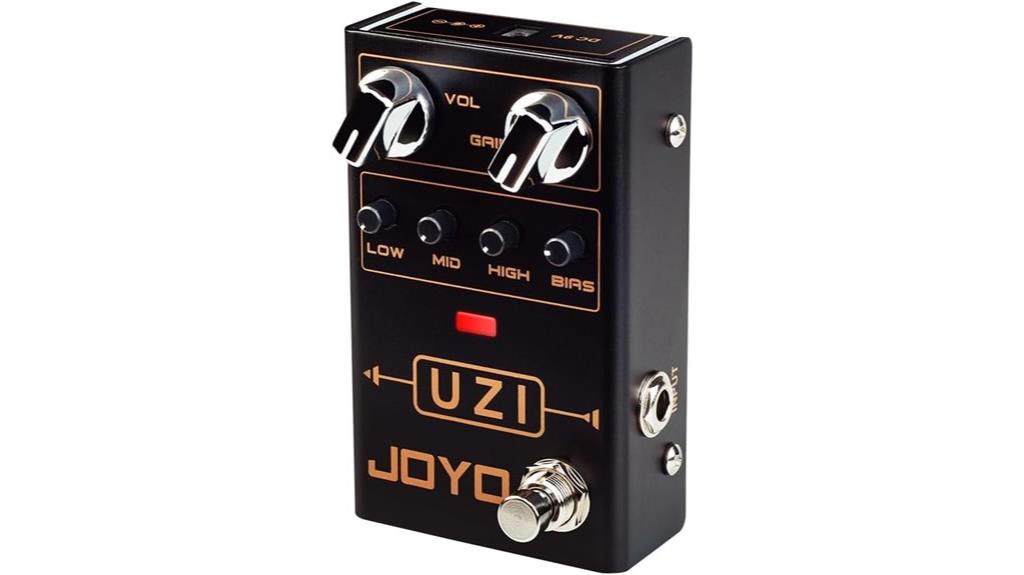
The JOYO UZI Distortion Pedal (R-03) stands out as an exceptional choice for metal guitarists who need crushing high-gain tones without breaking the bank, offering a unique BIAS knob that lets you switch between American and British distortion characteristics. Its GAIN and VOLUME controls maintain dynamic balance, allowing you to adjust settings without dramatically altering your overall volume levels, which proves incredibly useful during live performances. The metal enclosure delivers impressive durability at just 8.5 ounces, making it perfect for your pedalboard setup, while the futuristic design with ambient lighting adds visual appeal to any stage or studio environment.
Best For: Metal guitarists and heavy rock players who want high-gain distortion with versatile American/British tonal options at an affordable price point.
Pros:
- BIAS knob allows switching between American and British distortion characteristics for tonal versatility
- Dynamic balance between GAIN and VOLUME controls lets you adjust settings without dramatically altering overall volume
- Durable metal enclosure with futuristic ambient lighting design that’s both stage-ready and visually appealing
Cons:
- Does not operate well with standard 9-volt batteries and requires higher current power supplies
- Limited to distortion effects only, lacking the versatility of multi-effect or preamp pedals
- May require JOYO’s original power adapter for optimal performance, adding to the overall cost
Donner Distortion Guitar Pedal, Morpher Mini with 3 Modes
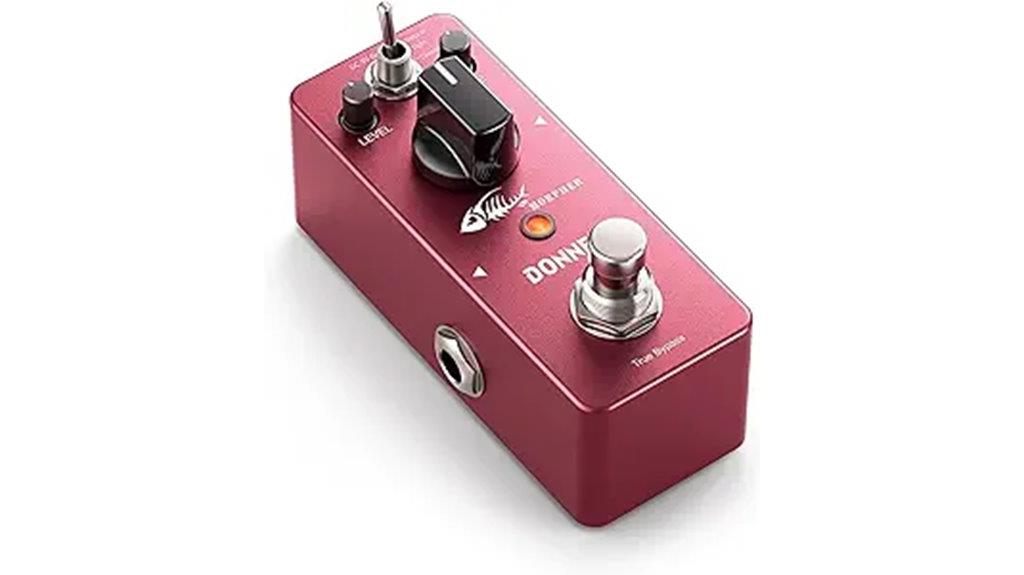
Budget-conscious guitarists seeking high-gain distortion that rivals premium pedals costing twice as much will find the Donner Morpher Mini delivers exceptional value through its three distinct modes and robust aluminum construction. You’ll appreciate how the Natural, Tight, and Classic Crunch modes provide versatility for hair metal, glam rock, and pop metal applications, while the true bypass circuitry maintains your signal integrity without frequency loss. The pedal’s compact 6.6 x 4.7 x 2.5-inch footprint won’t crowd your pedalboard, though you’ll need a separate 9V adapter since there’s no internal battery option, which honestly isn’t a dealbreaker given the consistent power delivery benefits.
Best For: Budget-conscious guitarists who want high-gain distortion with premium sound quality for metal genres, shredding, and riffing without breaking the bank.
Pros:
- Three versatile distortion modes (Natural, Tight, Classic Crunch) provide flexibility for various metal subgenres and playing styles
- True bypass circuitry maintains signal integrity with no tone loss or frequency degradation
- Durable aluminum-alloy construction in a compact footprint that won’t overcrowd your pedalboard
Cons:
- Requires external 9V power adapter as there’s no internal battery option
- Limited to rock/metal applications rather than being suitable for all musical genres
- Minimum 500mA current requirement may necessitate a higher-powered supply than basic adapters provide
AZOR Heavy Metal Distortion Guitar Pedal (3 Modes Effect Controls)

Metal guitarists seeking an affordable entry point into serious distortion territory will find the AZOR Heavy Metal Distortion Guitar Pedal offers surprising versatility through its three-mode control system, which combines traditional volume and distortion knobs with a dedicated mid-range control that’s often overlooked in budget pedals. You’ll appreciate the two-way selector switch providing both extreme and classic modes, allowing you to dial in everything from vintage crunch to modern high-gain saturation. The aluminum alloy construction feels solid despite weighing only 8.5 ounces, and the true bypass circuitry guarantees your clean tone remains uncolored when disengaged.
Best For: Metal guitarists on a budget who want versatile distortion options with both vintage crunch and modern high-gain capabilities, plus the flexibility to fine-tune their sound with dedicated mid-range control.
Pros:
- Three-mode control system with dedicated mid-range knob and extreme/classic selector switch provides exceptional tonal versatility for a budget pedal
- True bypass circuitry ensures clean tone remains unaffected when pedal is disengaged
- Durable aluminum alloy construction in a compact, lightweight design makes it reliable and portable for gigging
Cons:
- 9V DC power adapter not included, requiring separate purchase
- Some users report noise issues with certain models in the AZOR line
- Limited to distortion effects only, requiring additional pedals for comprehensive tone shaping
Boss DS-1 Distortion Pedal
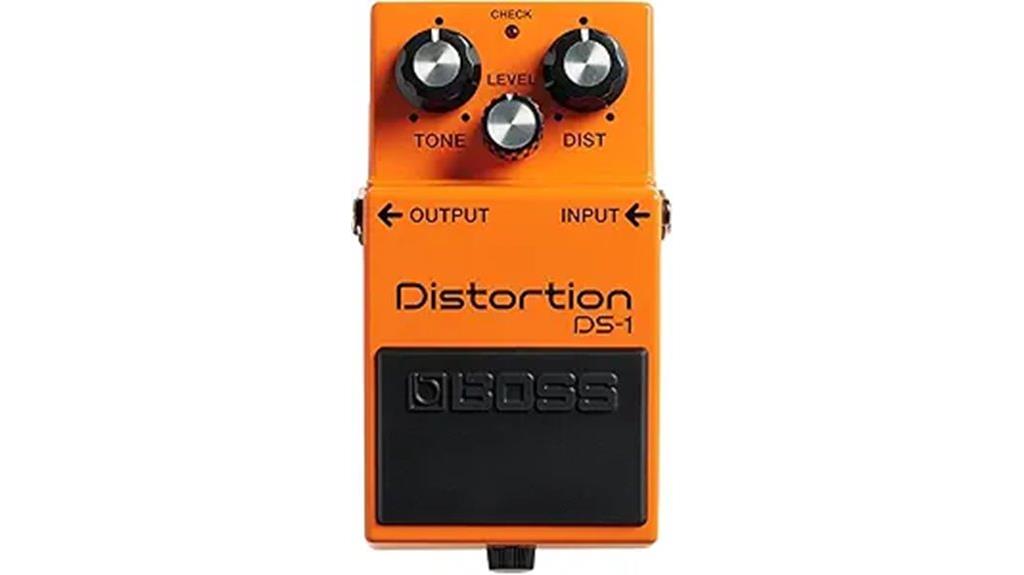
When you’re diving into metal guitar tones and need a pedal that won’t break the bank, the Boss DS-1 stands out as one of the most versatile workhorses in the distortion world, offering three straightforward controls—tone, level, and gain—that let you dial in everything from mild crunch to seriously aggressive saturation. With its 4.6-star rating from over 4,000 users and the #2 ranking in guitar distortion effects, this pedal has proven its worth across countless metal rigs, delivering the kind of reliable performance that’s made it a studio and stage staple for decades now.
Best For: Guitarists seeking an affordable, versatile distortion pedal that can handle everything from mild crunch to aggressive metal tones with reliable performance across different musical genres.
Pros:
- Three simple controls (tone, level, gain) make it easy to dial in a wide range of distortion sounds from subtle overdrive to heavy saturation
- Exceptional build quality and durability with a proven track record of longevity in both studio and live performance settings
- Outstanding value with a 4.6-star rating from over 4,000 users and #2 ranking in guitar distortion effects category
Cons:
- Sound quality can vary significantly depending on the guitar and amplifier being used, requiring experimentation to find optimal settings
- May not provide the extreme high-gain saturation that some dedicated metal players require for the heaviest genres
- Limited tonal shaping options with only basic tone, level, and gain controls compared to more advanced multi-parameter distortion pedals
Factors to Consider When Choosing a Distortion Pedal for Metal
When I’m helping guitarists choose the right distortion pedal for metal, I’ve learned that certain technical specifications can make or break your tone, regardless of how much you spend on the unit. The gain range determines how much saturation you’ll achieve, while multiple distortion modes give you versatility for different metal subgenres, and proper EQ controls let you shape frequencies to cut through dense mixes. I always tell players to evaluate build quality for road durability, true bypass circuitry for signal integrity, and how these features work together to create the aggressive, tight sound that metal demands.
Gain Range and Saturation
Since achieving the perfect metal tone depends heavily on your pedal’s gain capabilities, I can’t overstate how critical it is to understand gain range and saturation before making your purchase. The gain range determines your tonal versatility, allowing you to dial in everything from mild overdrive for classic metal to crushing high-gain saturation for extreme genres. Higher saturation levels deliver that aggressive, compressed sound you’ll need for modern metal, while also providing extended sustain that’s absolutely essential for lead playing. I’ve found that adjustable gain controls are non-negotiable, since they let you maintain clarity and definition even during complex chord progressions and lightning-fast solos. This versatility guarantees you’re covered across different metal styles.
Multiple Distortion Modes
Beyond raw gain power, multiple distortion modes represent one of the most valuable features you’ll find in modern metal pedals, giving you the flexibility to tackle everything from classic thrash to crushing doom without owning an entire pedalboard. I’ve found that pedals with at least three distinct modes—typically raw, brutal, and classic profiles—offer the versatility needed for different metal subgenres, allowing you to switch from tight, punchy tones to full-bodied aggression instantly. During live performances, I can’t overstate how useful it is to toggle between contrasting sounds for different songs or sections. The best pedals include independent sound shaping controls for each mode, letting you dial in precise volume, tone, and distortion levels that match your specific preferences and expand your creative palette considerably.
EQ Controls and Shaping
While multiple distortion modes give you sonic variety, the EQ controls ultimately determine whether your metal tone cuts through a mix or gets buried under layers of bass-heavy sludge. I’ve learned that independent treble, mid, and bass knobs provide the precision needed to carve out aggressive, articulate tones that maintain clarity at punishing gain levels.
What separates exceptional distortion pedals from mediocre ones is their EQ section’s ability to manage feedback while preserving note definition. I particularly appreciate pedals with mid-boost functions, which help achieve those signature heavy metal frequencies that make riffs feel like they’re cutting through concrete. The ability to switch between EQ settings lets me experiment with classic thrash brightness and modern djent-style low-end emphasis without constantly tweaking individual knobs during performances.
Build Quality and Durability
Perfect EQ control means nothing if your distortion pedal crumbles under the physical demands of metal performances, and I’ve witnessed too many guitarists learn this lesson the hard way when their plastic-bodied pedals crack during essential gigs. I always recommend metal chassis construction, particularly high-quality aluminum alloy designs that deliver exceptional durability while remaining surprisingly lightweight for transport. True bypass circuitry isn’t just about signal clarity—it actually protects internal components from wear, extending your pedal’s operational lifespan considerably. I’ve found that robust knobs and switches, combined with anti-skid rubber pads, make the difference between pedals that survive years of aggressive stomping and those that fail when you need them most.
True Bypass Circuitry
When I’m evaluating distortion pedals for metal applications, I’ve learned that true bypass circuitry represents one of the most critical yet underestimated features that separates professional-grade units from budget alternatives that compromise your core tone. True bypass allows your signal to pass through unaltered when disengaged, preventing tonal degradation and unwanted noise that can muddy heavy distortion sounds. For metal guitarists, this transparency becomes essential since clarity directly impacts how well your riffs cut through dense mixes. I’ve found that mechanical switches in true bypass pedals offer superior durability compared to buffered circuits, which can introduce signal loss or coloration. Some modern pedals provide both bypass modes, giving you flexibility based on your specific rig configuration and performance requirements.
Power Supply Requirements
Power supply requirements deserve serious attention in your pedal selection process, as I’ve discovered through countless gigs where inadequate power sources turned pristine metal tones into noisy, inconsistent disasters that could’ve been easily avoided. Most distortion pedals demand 9V DC power with center-negative polarity, though adapters aren’t always included in the package. While battery operation works, I recommend dedicated power supplies for consistent performance and reduced noise. High-gain metal pedals typically require minimum 500mA current delivery for ideal operation, especially during aggressive palm-muted passages. Daisy chain compatibility becomes vital when building larger pedalboards, allowing multiple effects to share a single adapter. Always verify your pedal’s specific requirements before purchasing power supplies, since mismatched voltage or polarity can damage circuits and ruin performances.
Pedal Size and Footprint
Pedalboard real estate becomes a premium commodity once you start accumulating the gear necessary for serious metal tones, and I’ve learned that selecting the right pedal dimensions can make or break your entire rig’s functionality. Compact mini pedals measuring 3.7 x 1.9 x 1.66 inches maximize space efficiency, while larger units at 6 x 3.8 x 2.7 inches demand strategic placement planning. I’ve found that mini designs weighing around 8.5 ounces considerably reduce transport burden during frequent gigs, where every pound matters when hauling gear up three flights of venue stairs. Top-mounted jacks on compact pedals allow closer adjacency, creating tighter configurations that optimize your board’s layout and minimize cable runs between effects.
Price and Value
Budget considerations profoundly impact your distortion pedal selection, and I’ve witnessed countless musicians struggle with the classic dilemma of balancing sonic aspirations against financial reality. I’ve found that excellent metal tones don’t necessarily require breaking the bank, as many $30-60 pedals deliver surprisingly robust performance that rivals pricier alternatives. Premium models exceeding $200 often provide marginal improvements that casual players won’t fully appreciate, though professional musicians might justify the investment. I always recommend checking user reviews and performance ratings to identify sweet spots where price meets quality effectively. Additionally, I consider resale value when purchasing, since popular models retain their worth better, and I prioritize manufacturers offering solid warranties and customer support to protect against unexpected repair costs.
On a final note
I’ve tested countless distortion pedals over the years, and these eight represent the cream of the crop for metal applications. Whether you’re chasing modern djent clarity with the Boss MT-2’s surgical EQ controls, or pursuing vintage thrash aggression through the DS-1’s mid-forward voicing, each pedal offers distinct sonic characteristics that’ll elevate your metal tone. Consider your amp’s natural voice, preferred gain staging approach, and budget constraints when making your selection.

